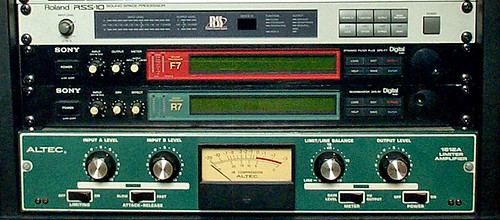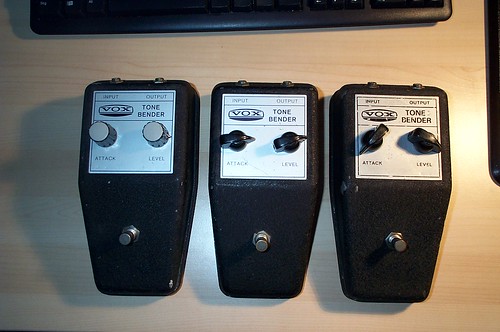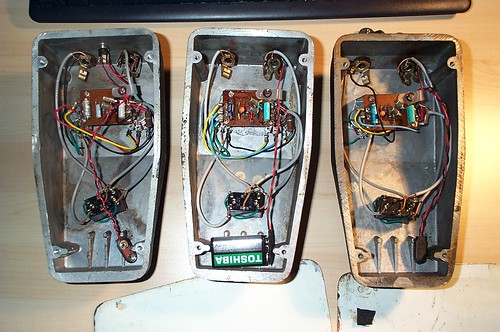Roland RSS-10 Software and Manuals
Posted 2008-12-11 in Effects by Johann.
At the top of this picture is a Roland RSS-10 Sound Space Processor. The RSS-10 is one of the most unique signal processors ever – it simulates three-dimensional audio. Sounds can be placed above, behind, away from and even below the listener at various distances.
Using a conventional two-channel system, sound can be placed or moved anywhere in the three-dimensional field. Computer controlled sound localization is accomplished using specialized software for either Macintosh® or Windows®.
- Sounds can be moved above, away, towards or around the listener
- Conventional two-channel playback
- Simulates flanging and Doppler effect
- Windows or Mac control software
- Up to 16 RSS-10s can be linked for 32 channels of 3-D playback
- Discrete stereo In/Out
When it came out at the beginning of the 90’s, these algorithms had to be run on DSPs.
Using a conventional two-speaker stereo reproduction system, a full three-dimensional sound image is created. The RSS-10 is used during the stereo mixdown process, with no encoders or decoders needed for final stereo reproduction.
The RSS system comprises a binaural processor which is the heart of the RSS system, a transaural processor and a distance processor that reproduces the distance from the sound source, and a reverb processor that simulates the sound reflection from any direction and creates realistic and precise reverberations.
A Stationary mode locates the sound image at a stationary position, while a Flying mode moves the sound image in real time. Both modes can be easily controlled on a personal computer (Mac or Windows) using software packages that come with the system.
An extremely interesting concept – that never really caught on.
If you would like to read more about the RSS-10, I once wrote a review for Harmony Central. There's also an FTP site that Roland set up.
Over the years, I was asked several times for the software or the manuals. Instead of emailing the files over and over, I decided to put them here on my blog.
- Download the Windows software. (290 KB)
- Download the Mac software. (1.4 MB)
- Download the manuals. (94 MB)
Note that the Mac software disk was not extracted by me. My disk was broken and I could never read it. I have no idea if it works and what the disk contains.
Alternatives
If you cannot find an RSS-10 – some of it has made it into various Roland and BOSS products. But these algorithms only support a fraction of the possibilities of the RSS-10. Here are some alternatives that you might be able to get:
Prosoniq Ambisone
I think that Ambisone is just as interesting to expand the stereo space as the RSS-10. It’s easier to use, but maybe not quite there in terms of quality over speakers.
QSound
I have the original DirectX QSound plugin. QSound is very effective at making the sound stage wider, but it cannot place sounds anywhere around the listener.
Simple diode clippers and distortion circuits
Posted 2007-08-23 in Effects by Johann.
Diodes are fun. They’ll readily distort your guitar signal like there’s no tomorrow and most are cheap, too. Diodes come in all shapes and sizes but the following general types are most used in guitar effects pedals.
I’m building octavers with lots of diodes here.
Dial “D” for diodes!
- Metal Simplex. (From diystompboxes.com)
- Electra Distortion. It doesn’t get much simpler. Sound clips.
- Bazz Fuss/BazzFuss. One transistor, one diode. Simple, but popular with bassists. Sound clips. (From HC CH)
- Buzz Box/BuzzBox. Twice the Bazz Fuzz for – more fun!
- The Bronx cheer. (From Guitar Effects)
- Atmos. My Green Ringer variant that was modified for a ton of LED distortion (if you want it).
With the exception of the Atmos, these DIY circuits are all really simple and shouldn’t take much longer than half an hour to build. Have fun!
Vox Tone Bender Germanium Fuzz
Posted 2008-07-10 in Effects by Johann.
The Vox Tone Bender is a 60’s Fuzz guitar effect. It’s very similar to the legendary Fuzz Face in design but sounds thinner, more aggressive. Despite the name, this Tone Bender flavour has little in common with the previous three-transistor incarnations.
Still, these do have Germanium transistors (SFT 363 E and SFT 337) so they must be good, right?
Audio Clips
In the sound sample, I use my Ibanez 2027XVV seven-string guitar into a little amp modeller.
Even though the images above show three Tone Benders, I sold two of them. Sorry.
3 comments
DIY Octavia pedals, boosters and treble boosters
Posted 2007-06-22 in Effects by Johann.
There’s a huge amount of DIY circuits available but most of them are scattered across the various DIY websites. In this post, I’ll provide you with links to simple circuits I have either built myself or heard good things about.
Octavia pedals
- Green Ringer
- The majestic Green Ringer (schematics). A classic. Downsides: Low on sustain. You can try my Atmos mod that adds LED distortion and a lot of output.
- The Octo-Booster
- Extremely simple and apparently a very clean octaver.
- Bobtavia
- JRC386-based octaver. Bobtavia video demo.
- Pushme Pullyou
- One of Tim Escobedo’s octavers (schematics). Pushme Pullyou clip, Pushme Pullyou transistor experiments.
Boosters
Boosters make your signal louder. Most of the time, they will add some distortion on their own. Boosters using J201 JFETs provide “juicy,” soft compression.
Boosters are some of the simplest circuits. If I can build and package one in two hours, you can do so, too.
- Stratoblaster
- Super easy and nice, round sounds.
- Booster recommendations
- Great review of popular boosters and the most creative packaging I’ve seen in a while.
- AMZ Mini-Booster
- Jack Orman’s highly popular booster/overdrive.
- Fetzer Valve
- A booster with some theory behind it. Easy, too.
- Discrete FET Guitar Preamp
- This one is just perfect to have around as a utility boost.
Treble boosters
- Omega
- Runoffgroove’s attempt at making a better, modern Rangemaster.
- Brian May treble boost
- No knobs – just boost!
Happy building!
Pages
Page 2 · Page 3 · Page 4 · Page 5 · Page 6 · Next Page »
Subscribe
RSS 2.0, Atom or subscribe by Email.
Top Posts
- DynaCloud - a dynamic JavaScript tag/keyword cloud with jQuery
- 6 fast jQuery Tips: More basic Snippets
- xslt.js version 3.2 released
- xslt.js version 3.0 released XML XSLT now with jQuery plugin
- Forum Scanners - prevent forum abuse
- Automate JavaScript compression with YUI Compressor and /packer/



